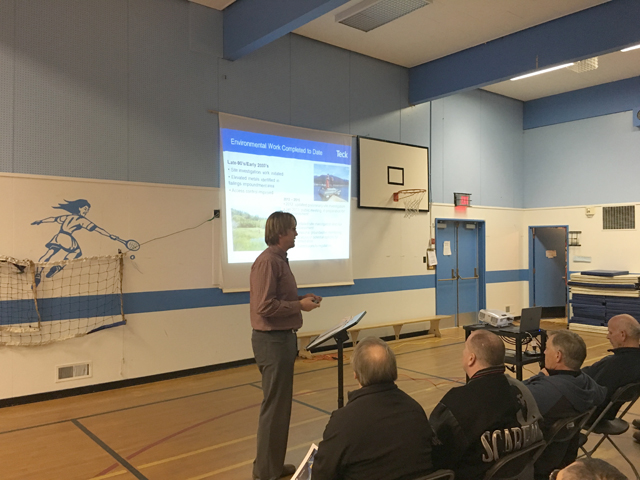Teck explains plan to deal with Fisherman’s Road tailings ponds
A proposal from Teck concerning the removal of tailings from areas along Fisherman’s road in Area E of the Regional District of Central Kootenay attracted concerns and questions from locals during an open house meeting at Blewett Elementary Tuesday night.
Tailings are the materials left over after valuable minerals are extracted from raw ore, and consist of slurry made up of water and particles ranging from a few micrometres to the size of a grain of sand and often include toxic or poisonous minerals.
In the case of the Fisherman’s road tailings, located approximately 10 kilometers west of Nelson, the materials causing the concern are arsenic and lead, originally from the Kenville mine, the oldest mine in BC, which were deposited over the years between 1890 and 1956.
Teck purchased the land in 1931.
A risk assessment conducted by Teck, which included digging test pits and drilling for soil samples, concluded that the tailings currently found in the area pose a risk to humans and local wildlife.
“All these samples were collected all over the place, and we determined where there are tailings,” Mark Tinholt, Superintendent for Environmental Remediation, Teck Trail Operations told the crowd of interested residents Tuesday.
“The concern for humans, in those tailings areas would be that there is arsenic and lead.”
Tinholt explained that ingestion of these materials would be cause for concern, but that merely walking on the area of breathing the air would not affect a human. As far as the local wildlife is concerned, levels in the water were too low too affect the fish, but Tinholt did say that insects and plant life could be disturbed.
A member of the crowd voiced trepidation regarding the disturbing of these materials during the process of excavation, and asked why Teck couldn’t just leave things as they were rather than risk contaminating things further by releasing compounds that have been buried for decades, on top of removing the plant life already growing there.
“When it comes to meeting the standard [we have to meet] under the regulations, we have to look at every scenario, which could mean people going in there and digging or playing on it as a beach,” Tinholt replied.
“It is unfortunate because we have to remove some of the vegetation currently growing there to put in a fix, but over the long term it’s more supportive.”
There were several options looked at by Teck when it came to fixing the issue, including fencing and signage and completely excavating and processing the entire area.
However, these plans were deemed as “not preferred options”, as signage and fencing could merely be ignored, and transporting and processing the material would involve over 5,000 truckloads being shipped to waste disposal facilities in Alberta and cost between $36-38 million.
The company decided on a course of action that will remove the tailings from the Main Bay, and consolidate them in the Tailings Impoundment. The area would then be covered in a metre of clean fill, which would have the added benefit of improving the habitat over the entire area.
While the plan is not set in stone, and meetings like the one held on Tuesday are geared towards hearing and addressing feedback from the public, the plan as proposed currently would take place over the next four years.
Between 2016 and 2017, engineering design and regulatory approvals and permits would be processed. Following that, in 2018 carrying into 2019, Teck would being a “phased approach” to implementing the remediation process, which would be subject to the approval and permit process.
Tinholt encouraged public response, and said that Teck is certainly open to receiving new information now that locals are aware of the plan.
“Future public access could be considered in remediation, if brought forward during the engineering design stage through the Regional District of Kootenay Columbia (RDCK) or a community society,” according to the presentation.
Teck’s Trail Operations, located in the community of Trail in British Columbia, includes one of the world’s largest fully integrated zinc and lead smelting and refining complexes and the Waneta hydroelectric dam and transmission system.
The metallurgical operations produce refined zinc and lead, a variety of precious and specialty metals, chemicals and fertilizer products.






















